

By September 1994, Dan Slingsby had departed and Alan Dykes took
his place. With the fresh blood, came a fresh look. The resultant
magazine dated, dated January 1995 symbolized the final stage of
the magazines development. To avoid confusion with others,
'magazine' was tagged onto the name. Many readers did not
look at the CU box on the title, leading to confusion that the
magazine was simply called 'AMIGA'. The new attachment gave the
publication brand awareness, when you want to buy an Amiga
magazine, buy CU Amiga Magazine.
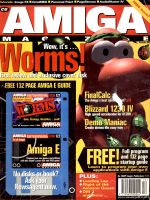 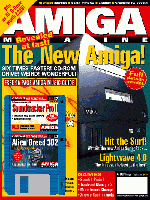 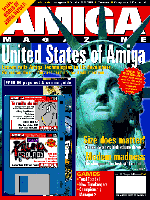
Amiga magazines were beginning to feel the pinch as Commodores'
death led to great uncertainty in the market. To counteract Amiga
Format's focus on games as the main driving force, CU Amiga aimed
more at the serious market. The number of tutorials increased,
covering previous cover disks such as ProCalc and Directory Opus 4.
They also began a series of DIY hardware installation tutorials. At
first it was installing a 3.5" hard drive into an A1200, but soon
expanded to cover tower conversions in later issues. Product
ratings were also becoming more realistic as they began to realize
the Amiga users who stayed behind did not have bottomless pockets.
1995 looked extremely bleak for the magazine as a slow death robbed
CU of its pages. The situation was not bad yet but without evidence
of a new machine, the platform seemed dead. In these dark days came
a glimmer of hope, the November '95 issue included a CD on the
cover. It was not a first for an Amiga magazine by any means,
AUI, Amiga
Power, and Amiga Computing all had
CDs on previous issues. The CD wasn't even created by the CU staff,
mostly consisting of Aminet 7. However, this was different as it
was not designed to be used with a standard CD32, requiring access
to Workbench. This was soon followed by the April and September
1996 editions that also included the CU 'Super CD-ROM.' The CUCD
became a regular occurrence from the November 1994 edition. This
made it the only Amiga magazine to have had a cassette tape (for
the C64), disk, and a CD on the cover during its lifetime. The
content had also changed from the shovelware of the Aminet CD to
one that was actually based upon the magazine, including software
mentioned that month. To herald the next generation of Amiga
magazine (one that includes a CD), CU dedicated a 10 page section
to the format, called CD Amiga. This soon dropped down to a few
pages and was incorporated into the rest of the magazine as the
format became the norm.
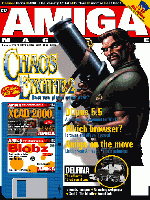
In December 1996, Alan Dykes quit and Tony Horgan took his place,
moving from technical editor to editor. Under his control the
magazine got a new life with a series of imaginative articles and
features. The magazine staff shrunk to a small, but highly
dedicated group, including Mat Bettinson, Andrew Korn and Neil
Bothwick. Despite the drop in circulation since the beginning of
the year (ABC January - June 1996: 36,856 compared to July -
December 28,161), the magazine continued to improve. The lead
feature always attempted to guide the reader and explain matters,
covering subjects such as the range of Amiga-compatible OS' and
computers that were appearing (May '97), Internet radio, tower
conversions (putting an A1200 in a tower), and adding Zorro slots.
The magazine also hosted world exclusives not found in any other
magazine, such as Suzanne, the DIY Amiga laptop made from an
A600.
The magazine began to recognize the technical nature demanded by
many readers and attempted to upgrade the Amiga. Emphasizing the
expansion possibilities, CU Amiga in association with ClickBoom
presented a wish list of games to be converted to the Amiga. By
showing there was a demand for such games they hoped to save the
Amiga from the vicious circle that plagued the market- people would
not upgrade because game companies did not produce games requiring
a higher spec, which in turn there would not be enough Amiga users
that were able to run the game. The magazine even improved on the
Amigas audio hardware by including a PCB on the cover. A first for
an Amiga magazine! The Project XG PCB on the September 1997 issue
allowed any Amiga to use 16-bit sound when combined with an XG
sound card. CU Amiga suffered the smallest drop in readership, just
2.7 from 28,161 (July- Dec '96) to 27,391 (Jan-June '97). Despite
the number of people leaving the market, the drop in readership can
be blamed on those using the internet to get the latest Amiga news
and software. In a way, the Amiga magazines shot themselves in the
foot by teaching people how to get onto the Internet, and become
self reliant!
The cover software had also continued to improve of 1997 with a
host of serious software, including Image Studio (May), ProPage 4.1
(June), Storm C Compiler + Turbo Print 5 Lite (August), and Vista
Pro (September). October bought the first release of TFX. A flight
simulator originally due for release in 1994 that had been
continually delayed and then canceled by its creators.
The December 1997 issue represented a contradiction in the Amiga
market. If it was dying, as many were saying, how could CU Amiga
afford to increase the number of pages from 108 (where it had been
since November 1996) to 116? Having expanded the Amiga in the past
year, CU set its sights on running software on the improved
processors. The December edition gave away the full version of PC
Task 3.1, with MS DOS 3.3, allowing Amiga users to run 286
software. There was also a feature on the spec needed to run
certain Mac games on the Amiga. Soon followed by a lead feature on
setting up the MacOS in the April '98 edition. This issue included
a version of Shapeshifter, as well as the freely-distributable
MacOS 7, and a range of Mac software for use with the new OS.
The high quality features continued with articles on ISDN, the
Millennium Bug (which surprising many by showing the Amiga did
suffer from it to an extent), media processors, and the potential
AmigaNG kernel, BeOS.
CU Amiga- The Lawbreaker
The addition of the CUCD allowed more material to be included with
the magazine. In attempting to include the material readers wanted,
the magazine sometimes accidentally broke copyright on some
software. The oft mentioned MacOS that was part of the Shapeshifter
special was not illegal, being freely distributable. The only dodgy
thing about it was the fact it was intended for use under emulation
rather than the real McCoy. The publisher got into trouble with the
distribution of the AP2 web site - A collection of articles from
Amiga Power. Legal action ensued resulting in EMAP paying for the
magazines mistake. Confusingly no one seemed to notice the
inclusion of MS DOS 3.3 on the PC Task hardfile. There was also an
incident in the last issue where CU accidentally included a set of
icons, which many would consider to be pornographic. CU Amiga
ingratiated itself to the readers providing software the readers
wanted, but in some cases accidentally walked the wrong side of
legality.
The Covers
The magazine covers had always been feature lead (based upon an
article rather a particular product or game), with the possible
exception of the Quake cover. It is here where the writers
abilities shined, with a series of eye-catching, imaginative
covers. Who can forget the likes of the controversial Space Boy
(June '98) for the games programming feature, or the Sperm cover
(September '98) for the "Come together" networking article. In
comparison to Amiga Format's rather bland design these were
fantastic, showing that the Amiga was not dead.
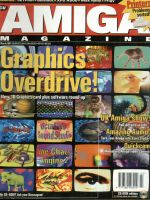 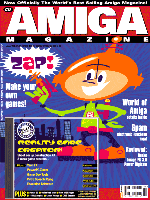
End of an Era
The ride had to come to an end eventually but few expected it to
come so soon- just when it became the world's biggest selling Amiga
magazine. Dated October 1998, it was exactly 15 years since the
first issue had rolled off the presses. The announcement of the closure was made on the
CU-List on August 17th, the same day the official UK magazine
circulation figures were released. This showed a drop in readership
from 24, 358 (ABC July - December 1997) to 21, 599 (January - June
1998). The magazine had dropped into losses and rather than halving
the staff, pages and reducing the quality of the magazine it was
decided to allow it to go out with a bang. It was cancelled for the
EMAP shareholders. Ironically the figures showed the magazine was
still the worlds' biggest selling Amiga magazine in the world.
The final issue met the high expectations with a final stab at
immortality. Like previous issues it was still 108 pages. The cover
was printed upside down with the logo appearing at the bottom
crushed by a replica Monty Python foot (unfortunately not the
official one because CU could not get permission). Unlike other
magazines (Amiga Computing, Amiga Action and Amiga User
International immediately springing to mind), EMAP had obviously
trusted the CU staff to create a final issue that was of the same
high standard. This trust was well rewarded with the usual range of
technical (Tech Scene) and game (Screen Scene) reviews, examining
titles such as X Men: Ravages of the Apocalypse and the Ateo
Bus.
Realizing the effect that the magazines closure could have on the
market, the final issue broke from tradition by looking to the
future rather than the past. Features included an interview with
Fleecy Moss, then of Amiga Inc. and a look at some of the other
Amiga magazines available. The magazine attempted to show, despite
its demise the Amiga market was still alive. The Points of View
section allowed the CU staff to reflect on the end of CU Amiga and
the future of the platform.
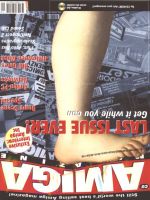
A Fitting End?
It's hard to say if CU Amiga Magazine had a fitting death.
Certainly the magazine ended on a high note rather than face the
humiliation of page cuts and staff layoffs. Emap had already sold
'The One Amiga' to another publisher (Maverick) and seen its name
dragged through the mud. To do the same with CU would border on
traitorous.
The CU staff pulled out all the stops to make this one of the best
issues ever. However, there was no sense of closure, perhaps
because they were trying to show that the market was still very
much alive. The magazine went out of its way to show alternative
titles that would take its readers into the next century. Still,
the 15 year arc remains incomplete. Apart from a small image of
1985 edition of Commodore User there is no sign of the magazines
history. The magazine lacks any analysis of the past, the change in
the market and the magazine as a result. Perhaps it is asking too
much. Its evolution caused it to reach many an en-passe - points of
no return. The hundred or more writers that have worked on the mag
have bought a range of skills that have shaped its course. Even
EMAP do not seem to possess a first edition of Commodore User. The
only consistency between the first and last issue was the
self-indulgency of the covers, heralding the birth and death of the
magazine.
For the first time since the birth of the computer industry there
was no magazine to cover it in CU's immutable style. There is only
one final thing to say about the magazine that has seen the
industry evolve from its first breath to the multimedia revolution.
See you,
CU!
Back to CU
Index
Back to CU
Amiga
Forward to
CU2000 |













